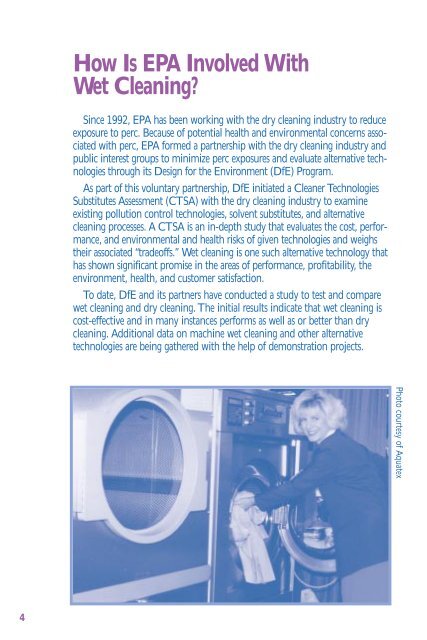Wet Cleaning - CLU-IN
Wet Cleaning - CLU-IN
Wet Cleaning - CLU-IN
- TAGS
- cleaning
- clu-in.org
Create successful ePaper yourself
Turn your PDF publications into a flip-book with our unique Google optimized e-Paper software.
4<br />
How Is EPA Involved With<br />
<strong>Wet</strong> <strong>Cleaning</strong>?<br />
Since 1992, EPA has been working with the dry cleaning industry to reduce<br />
exposure to perc. Because of potential health and environmental concerns associated<br />
with perc, EPA formed a partnership with the dry cleaning industry and<br />
public interest groups to minimize perc exposures and evaluate alternative technologies<br />
through its Design for the Environment (DfE) Program.<br />
As part of this voluntary partnership, DfE initiated a Cleaner Technologies<br />
Substitutes Assessment (CTSA) with the dry cleaning industry to examine<br />
existing pollution control technologies, solvent substitutes, and alternative<br />
cleaning processes. A CTSA is an in-depth study that evaluates the cost, performance,<br />
and environmental and health risks of given technologies and weighs<br />
their associated “tradeoffs.” <strong>Wet</strong> cleaning is one such alternative technology that<br />
has shown significant promise in the areas of performance, profitability, the<br />
environment, health, and customer satisfaction.<br />
To date, DfE and its partners have conducted a study to test and compare<br />
wet cleaning and dry cleaning. The initial results indicate that wet cleaning is<br />
cost-effective and in many instances performs as well as or better than dry<br />
cleaning. Additional data on machine wet cleaning and other alternative<br />
technologies are being gathered with the help of demonstration projects.<br />
Photo courtesy of Aquatex

















